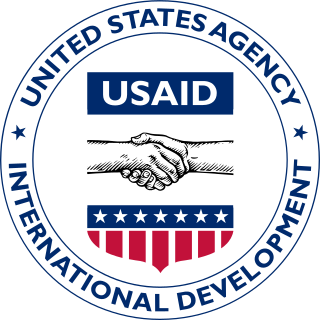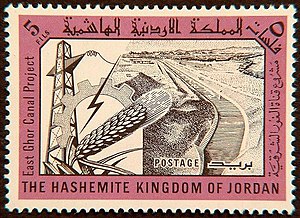
The United States Agency for International Development (USAID) is an independent agency of the United States government that is primarily responsible for administering civilian foreign aid and development assistance. With a budget of over $50 billion, USAID is one of the largest official aid agencies in the world and accounts for more than half of all U.S. foreign assistance—the highest in the world in absolute dollar terms.

The Global Environment Facility (GEF) is a multilateral environmental fund that provides grants and blended finance for projects related to biodiversity, climate change, international waters, land degradation, persistent organic pollutants (POPs), mercury, sustainable forest management, food security, and sustainable cities in developing countries and countries with economies in transition. It is the largest source of multilateral funding for biodiversity globally and distributes more than $1 billion a year on average to address inter-related environmental challenges.

Development aid is a type of aid given by governments and other agencies to support the economic, environmental, social, and political development of developing countries. It is distinguished from humanitarian aid by aiming at a sustained improvement in the conditions in a developing country, rather than short-term relief. The overarching term is foreign aid. The amount of foreign aid is measured though official development assistance (ODA). This is a category used by the Development Assistance Committee (DAC) of the Organisation for Economic Co-operation and Development (OECD) to measure foreign aid.

In international relations, aid is – from the perspective of governments – a voluntary transfer of resources from one country to another. The type of aid given may be classified according to various factors, including its intended purpose, the terms or conditions under which it is given, its source, and its level of urgency. For example, aid may be classified based on urgency into emergency aid and development aid.
Japan has been establishing its foreign aid contributors since the 1990s. The three government institutions involved in disbursing this are: the Japan International Cooperation Agency (JICA), and the Japanese Bank of International Cooperation (JBIC). This is now the nodal agency for all Japanese concessional loans, and replaced Japan Export-Import Bank (JEXIM) and the Overseas Economic Cooperation Fund (OECF) in 1999.
Japan emerged as one of the largest foreign aid donors in the world during the 1980s.

The Swiss Agency for Development and Cooperation (SDC) is an office-level agency in the federal administration of Switzerland, and a part of the Federal Department of Foreign Affairs. Together with other federal offices, SDC is responsible for overall coordination of Swiss international development activities and cooperation with Eastern Europe, as well as humanitarian aid.
Haiti—an island country 600 miles off the coast of the U.S. state of Florida—shares the Caribbean island of Hispaniola with the Dominican Republic. Haiti has received billions in foreign assistance, yet persists as one of the poorest countries and has the lowest human development index in the Americas. There have been more than 15 natural disasters since 2001 including tropical storms, flooding, earthquakes and hurricanes. The international donor community classifies Haiti as a fragile state. Haiti is also considered a post-conflict state—one emerging from a recent coup d'état and civil war.
US$43 billion in International Monetary Fund (IMF) aid in 2003 was sent as foreign aid to Indonesia, and this assistance has traditionally been an important part of the central government's budget. From 1967 to 1991, most aid was coordinated through the Inter-Governmental Group on Indonesia (IGGI) founded and chaired by the Netherlands; since 1992, without the Netherlands, the organization has been known as the Consultative Group on Indonesia (CGI). Although Indonesia terminated its IMF aid program in December 2003, it still receives bilateral aid through the CGI, which pledged US$2.8 billion in grants and loans for 2004. Japan and the Asian Development Bank also have been key donors.
Nepal relies heavily on foreign aid, and donors coordinate development aid policy through the Nepal Development Forum, whose members include donor countries, international financial institutions, and inter-governmental organizations. Japan is Nepal's largest bilateral aid donor, and the World Bank and Asian Development Bank are the largest multilateral donors. Donors have been reported as losing confidence in Nepal as a result of political interference and corruption in poverty relief efforts as well as the country's apparently poor capacity to utilize aid. According to World Bank figures, official development assistance increased from US$8.2 million in 1960 to US$369 million in 2003 and then fell to US$177 million in 2004. According to Nepal's Ministry of Finance, total foreign aid committed in fiscal year (FY) 2003 was US$555 million, with 63.3 percent in grants and 36.7 percent in loans. In FY2004, total foreign aid committed was US$320 million, of which 37.7 percent was grants and 62.3 percent, loans. In June 2004, active World Bank credits totaled US$302 million, with the greatest portions allocated to the financial sector and to energy and mining. By the end of 2012, the outstanding World Bank IDA loan totaled $ 1.48 billionArchived 2015-05-05 at the Wayback Machine.
International aid has been provided to Palestinians since at least the 1948 Arab–Israeli War. The Palestinians view the aid as keeping the Israeli–Palestinian peace process going, while Israelis and other foreign policy authorities have raised concerns that it is used to fund terrorism and removes the imperative for Palestinians to negotiate a settlement of the Israeli–Palestinian conflict. As a provision of the Oslo Accords, international aid was to be provided to the Palestinians to ensure economic solvency for the Palestinian National Authority (PA). In 2004, it was reported that the PA, within the West Bank and Gaza Strip, receives one of the highest levels of aid in the world. In 2006, economic sanctions and other measures were taken by several countries against the PA, including suspension of international aid following Hamas' victory at the Palestinian Legislative Council election. Aid to the PA resumed in 2008 following the Annapolis Conference, where Hamas was not invited. Aid has been provided to the Palestinian Authority, Palestinian non-governmental organizations (PNGOs) as well as Palestinian political factions by various foreign governments, international organizations, international non-governmental organizations (INGOs), and charities, besides other sources.
In different administrative and organizational forms, the Food for Peace program of the United States has provided food assistance around the world for more than 60 years. Approximately 3 billion people in 150 countries have benefited directly from U.S. food assistance. The Bureau for Humanitarian Assistance within the United States Agency for International Development (USAID) is the U.S. Government's largest provider of overseas food assistance. The food assistance programming is funded primarily through the Food for Peace Act. The Bureau for Humanitarian Assistance also receives International Disaster Assistance Funds through the Foreign Assistance Act (FAA) that can be used in emergency settings.
Water supply and sanitation in Jordan is characterized by severe water scarcity, which has been exacerbated by forced immigration as a result of the 1948 Arab–Israeli War, the Six-Day War in 1967, the Gulf War of 1990, the Iraq War of 2003 and the Syrian Civil War since 2011. Jordan is considered one of the ten most water scarce countries in the world. High population growth, the depletion of groundwater reserves and the impacts of climate change are likely to aggravate the situation in the future.

United States foreign aid, also known as US foreign assistance consists of a variety of tangible and intangible forms of assistance the United States gives to other countries. Foreign aid is used to support American national security and commercial interests and can also be distributed for humanitarian reasons. Aid is financed from US taxpayers and other revenue sources that Congress appropriates annually through the United States budget process. It is dispersed through "over 20 U.S. government agencies that manage foreign assistance programs," although about half of all economic assistance is channeled through the United States Agency for International Development (USAID).

Ecotourism in Jordan has grown tremendously due to environmental pressures and the demand for jobs outside of the cities, especially since the establishment of the Dana Biosphere in 1993, the first biosphere reserve.

The Board for International Food and Agricultural Development (BIFAD) advises the United States Agency for International Development (USAID) on issues concerning agriculture, higher education in developing countries, and food insecurity. BIFAD was established and recognized by Title XII of the Foreign Assistance Act, and both the BIFAD board and Title XII recognize the critical role of U.S. land-grant institutions in food and agricultural security, domestically and abroad. BIFAD consists of seven board members appointed by the White House, four of whom must have been part of the US Academic community. The board's mission is to draw on the expertise and scientific knowledge of those in higher education to advise the US international assistance on the effect of domestic efforts to end food insecurity.
Waste management in Kazakhstan is an important concern within the country, considering the billions of tons of industrial waste produced yearly, the currently less-than-optimal state of solid waste management, and existing toxins remaining from both pollutants and Kazakhstan's historical position as the USSR's testing grounds for rockets and nuclear weapons. Kazakhstan has very few services for recycling solid waste, and waste management is currently dealt with using regional programs.
Foreign aid for gender equality in Jordan includes programs funded by governments or non-governmental organizations (NGOs) that aim to empower women, close gender based gaps in opportunity and experience, and promote equal access to education, economic empowerment, and political representation in the Hashemite Kingdom of Jordan.

Climate change in Tanzania is affecting the natural environment and residents of Tanzania. Temperatures in Tanzania are rising with a higher likelihood of intense rainfall events and of dry spells.
Indian foreign aid is the aid given by the Indian government to other governments. India's major quantum of foreign aid is given to neighbouring countries. According to India's budget in 2021–22, its direct overseas aid stood at ₹18,154 crore (US$2.2 billion). That apart, India also extended a direct line of credit worth $30.66 billion to several foreign countries for developmental projects. India has set up 'Indian Agency for Partnership in Development' as a part of Ministry of External Affairs (India) to channelize aid to recipient nations.









